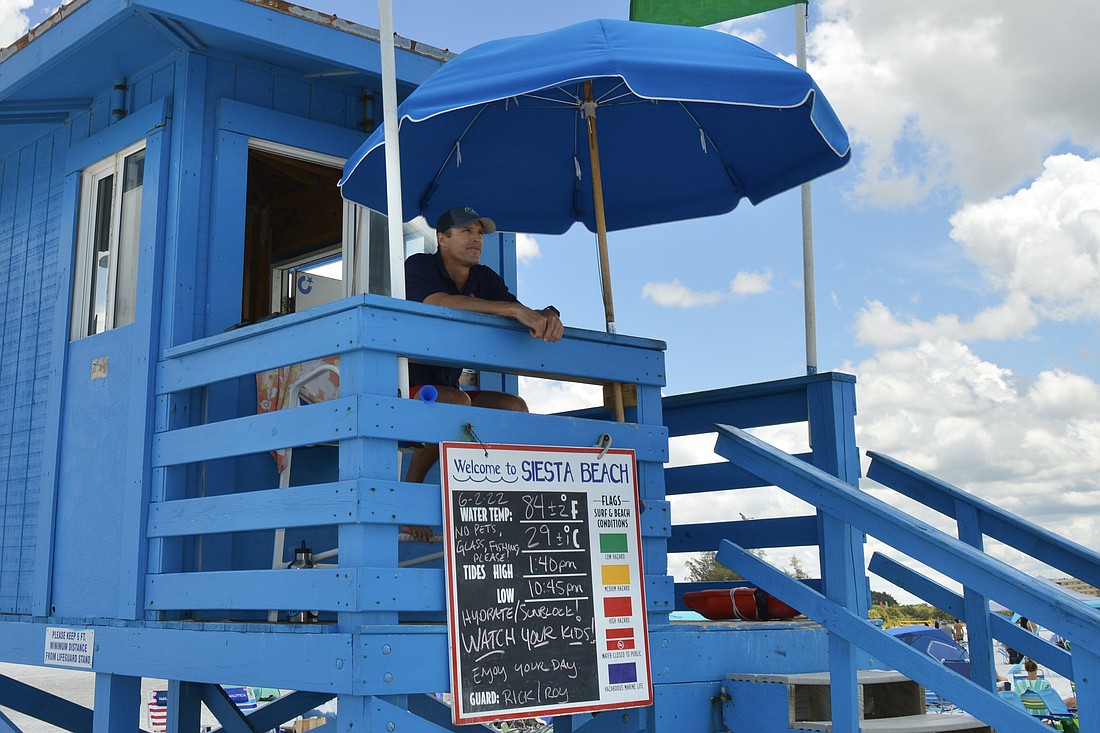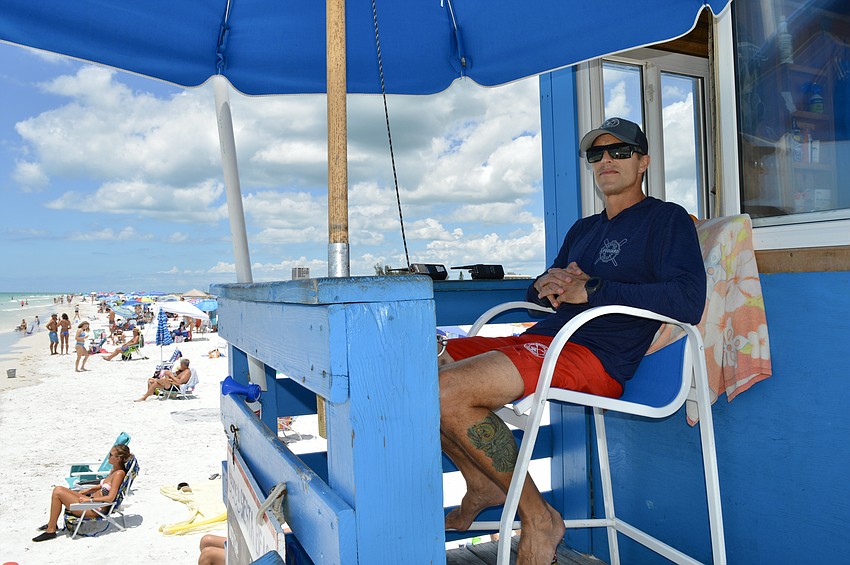- October 23, 2024
-
-
Loading

Loading

For Rick Hinkson, Sarasota County's lifeguard manager, being a lifeguard is all about the people.
It’s about making sure beach visitors head home safe, of course, but it's also about getting to know them, whether they’re locals, or tourists discovering what Sarasota has to offer.
“Sometimes we're the only Sarasota County employee that people encounter,” he said. “I like to think that our team does a really good job of representing the county government, representing the city, and being able to share the great things about this community and this area.”
Hinkson has been interested in lifeguarding since he was a child growing up in western New York involved in competitive swimming. He also visited Daytona and New Smyrna beaches in Florida, eventually serving as a lifeguard, starting at age 15, at Lake Ontario.
After a stretch of time spent in broadcast communications, his degree field, he made a move to Florida and discovered the profession once again, realizing that it was, in fact, a career choice of its own.
This is not to say that the job is easy.
As Hinkson described, there is constant training involved, as well as staffing issues in the wake of the COVID-19 pandemic. Yet it’s a role he’s keen to continue in each day.
“This mission, this job, and this lifestyle, fit into what I wanted to achieve when I moved down here,” he said. “I didn’t really think it was going to turn into what it has, but I think that happens to a lot of people who go into the profession.”
Before lifeguards take to their towers at 10 a.m. each morning, they start the day with training.
But you might find Hinkson already on the move before that time, working out at 5:30 a.m. in order to ensure he can fit the session into his busy schedule.
Recently, Hinkson has been serving in the towers periodically, where he will stand for over half the day. In a climate that has seen staffing shortages, he has more on his plate than he has in the past.
Hinkson’s journey with the county began as a seasonal employee, moving on to a full-time lifeguard in September of 1999, a lieutenant in 2002 and a captain in 2018. He has served in his current role since January of 2022.
There’s more to the role of a lifeguard than keeping watch, he said.
A portion of the job is customer service, which includes ensuring people know about local ordinances.
“A good lifeguard is a dry lifeguard, meaning if you've done your job well, you've communicated all of the things you need to communicate to the people who are on your beaches, you should not have to be going out and making rescues,” he said, noting that rescues cannot be avoided entirely.
Beachgoers can do their part to avoid having to be rescued, he said, by being aware of conditions and hazards, as even in lifeguarded areas rip currents can emerge and endanger swimmers.
In addition to serving the public, he also enjoys the scenic nature of the job.
“We've got six different locations that we work at, so depending on where you work, you see different locals, you see different people, you see different things pretty much every day,” he said.

And each week, there is another important piece: the rescues themselves.
“When you're leaving your tower to make a rescue, and you've radioed to your teammates that you're going in, every single time that happens, that's an intense experience,” he said. “I can't tell you how many calls have left their mark on me personally, and have made me a better lifeguard, and have made me make sure that I'm doing everything correctly.”
There have been more than 100 rescues this year, he said, some of which took place amid the rough waters following Hurricane Idalia.
Lifeguards also manage medical events on the beaches and outside their response zone with the Sarasota County Fire Department. In recent months, medical responses have increased significantly, Hinkson said.
“Lifeguards in general are a pretty healthy bunch,” he said. “A lot of our team does maintain things outside of work and you'll see us out running and swimming on our days off.”
There's plenty that lifeguards must do in order to maintain their jobs, he said.
“You can't just get this job and put your feet up and expect to keep it; you have to maintain a certain level of swimming and running ability, and it's not easy," he said.
In fact, many lifeguards with the county are triathletes, endurance runners, or paddlers, he said.
Every morning, lifeguards undergo an hour of training that includes simulated active rescue scenarios, including ones involving CPR and an automated external defibrillator.
That training helps lifeguards maintain their skills for an evaluation every six months by the U.S. Lifesaving Association, and also keeps continuing education credits for EMTs and first responders.
The evaluation involves a 500-meter swim test in 10 minutes or less, plus a 200-meter run down the beach and a 50-meter swim to a victim. In Sarasota County, a half-mile run is incorporated as well.
New hires undergo a four-week minimum training period to become certified as a open-water lifeguards and first responders. They're also trained in basic life support and AED use.
Contributing to the challenges of the role, he said, are staffing shortages currently impacting the profession on a national level. This has been continuing for about two years, Hinkson said.
“I just wear a few more hats during the day, I've always focused on my managerial duties, but it's important that I am still there for my team when it's needed,” he said.
The program itself has seen changes over time as well.
Personal watercraft were incorporated years ago. While around two years ago, ties with the fire department began, involving lifeguards in emergency responses off-site.
“We've been able to kind of branch out the last couple of years,” he said. “The responsibility of a lifeguard has always been prevention, however, what it encompasses is very much tied to response.”
He noted some improvements that are emerging. The starting pay for lifeguards in the county increased on Oct. 1 from $17.03 to $19.13.
Also, last month, three new hires joined the county, and will be starting their roles in the next six weeks.
On top of that, the team always remains very committed to their work, Hinkson said.
“The people who are out here who are lifeguards take it very seriously, and are very good at what they do.”